Group Think Analysis: Understanding Causes, Symptoms, and Solutions
VerifiedAdded on 2022/08/13
|7
|1625
|15
Homework Assignment
AI Summary
This assignment delves into the concept of groupthink, exploring its complex nature within decision-making processes. The student analyzes the causes of groupthink, including factors like cohesiveness, restrained access to outside ideas, budgetary issues, and stress. The assignment also identifies the symptoms of groupthink, such as the illusion of invulnerability, self-esteem, rationalization, stereotyping, self-censorship, mind guarding, unquestioned beliefs, and the illusion of unanimity. Furthermore, the assignment discusses strategies to overcome groupthink, emphasizing the role of open communication and critical evaluation. The student reflects on personal experiences with groupthink and applies the Katzenbach and Smith's team performance curve model to assess team dynamics. The assignment concludes with an analysis of the team's current stage of development and the necessary steps to become a high-performing team.
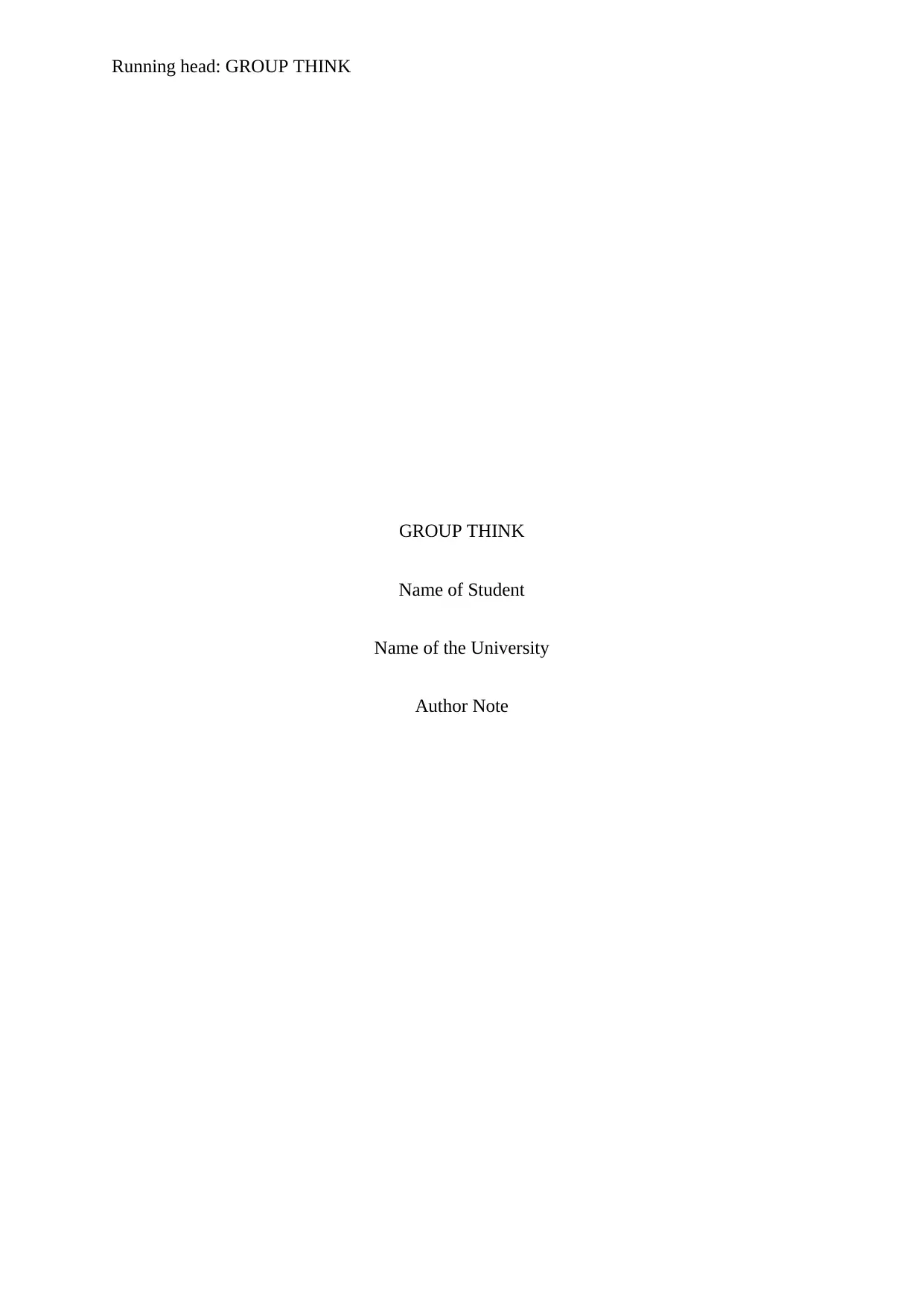
Running head: GROUP THINK
GROUP THINK
Name of Student
Name of the University
Author Note
GROUP THINK
Name of Student
Name of the University
Author Note
Paraphrase This Document
Need a fresh take? Get an instant paraphrase of this document with our AI Paraphraser
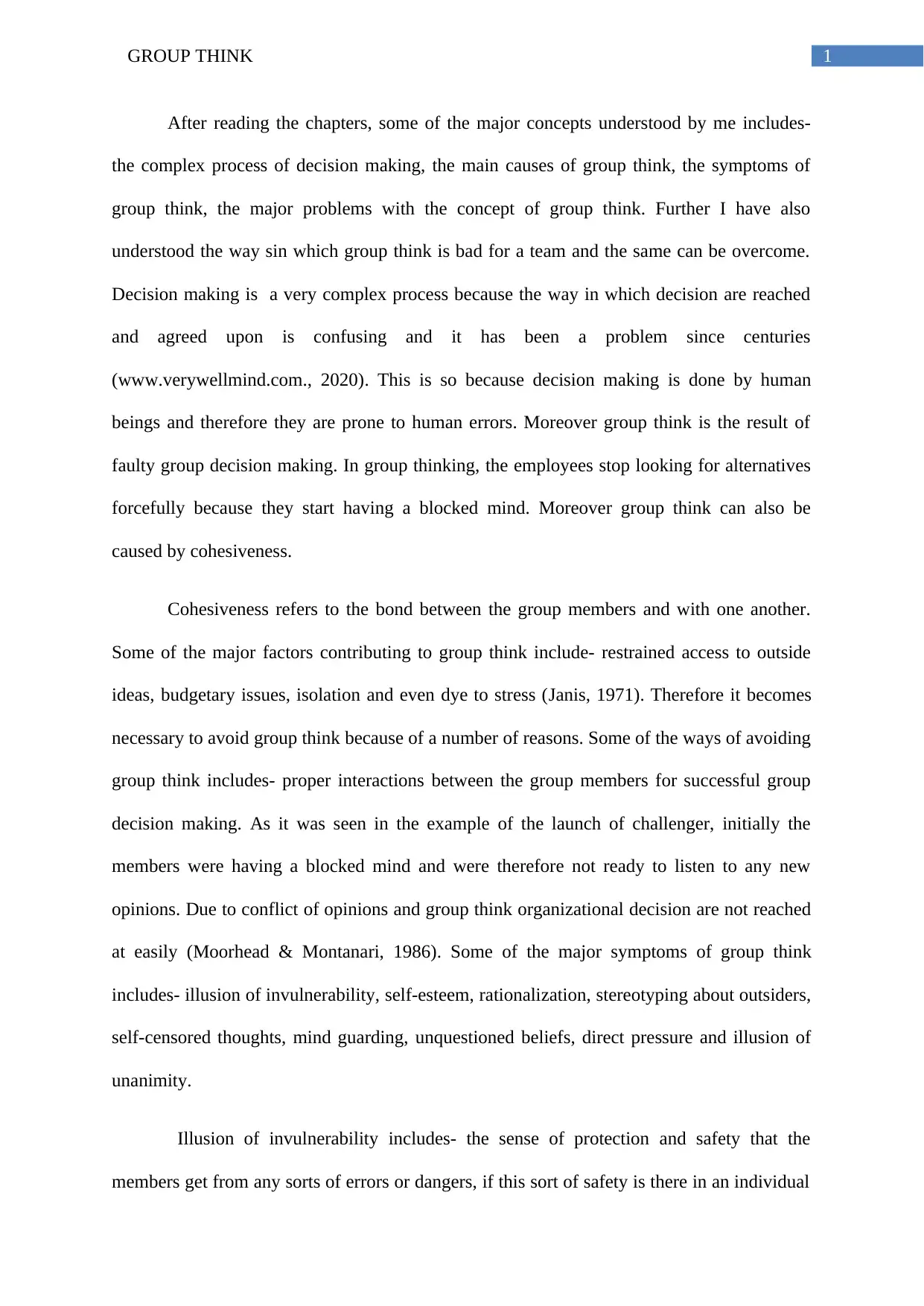
1GROUP THINK
After reading the chapters, some of the major concepts understood by me includes-
the complex process of decision making, the main causes of group think, the symptoms of
group think, the major problems with the concept of group think. Further I have also
understood the way sin which group think is bad for a team and the same can be overcome.
Decision making is a very complex process because the way in which decision are reached
and agreed upon is confusing and it has been a problem since centuries
(www.verywellmind.com., 2020). This is so because decision making is done by human
beings and therefore they are prone to human errors. Moreover group think is the result of
faulty group decision making. In group thinking, the employees stop looking for alternatives
forcefully because they start having a blocked mind. Moreover group think can also be
caused by cohesiveness.
Cohesiveness refers to the bond between the group members and with one another.
Some of the major factors contributing to group think include- restrained access to outside
ideas, budgetary issues, isolation and even dye to stress (Janis, 1971). Therefore it becomes
necessary to avoid group think because of a number of reasons. Some of the ways of avoiding
group think includes- proper interactions between the group members for successful group
decision making. As it was seen in the example of the launch of challenger, initially the
members were having a blocked mind and were therefore not ready to listen to any new
opinions. Due to conflict of opinions and group think organizational decision are not reached
at easily (Moorhead & Montanari, 1986). Some of the major symptoms of group think
includes- illusion of invulnerability, self-esteem, rationalization, stereotyping about outsiders,
self-censored thoughts, mind guarding, unquestioned beliefs, direct pressure and illusion of
unanimity.
Illusion of invulnerability includes- the sense of protection and safety that the
members get from any sorts of errors or dangers, if this sort of safety is there in an individual
After reading the chapters, some of the major concepts understood by me includes-
the complex process of decision making, the main causes of group think, the symptoms of
group think, the major problems with the concept of group think. Further I have also
understood the way sin which group think is bad for a team and the same can be overcome.
Decision making is a very complex process because the way in which decision are reached
and agreed upon is confusing and it has been a problem since centuries
(www.verywellmind.com., 2020). This is so because decision making is done by human
beings and therefore they are prone to human errors. Moreover group think is the result of
faulty group decision making. In group thinking, the employees stop looking for alternatives
forcefully because they start having a blocked mind. Moreover group think can also be
caused by cohesiveness.
Cohesiveness refers to the bond between the group members and with one another.
Some of the major factors contributing to group think include- restrained access to outside
ideas, budgetary issues, isolation and even dye to stress (Janis, 1971). Therefore it becomes
necessary to avoid group think because of a number of reasons. Some of the ways of avoiding
group think includes- proper interactions between the group members for successful group
decision making. As it was seen in the example of the launch of challenger, initially the
members were having a blocked mind and were therefore not ready to listen to any new
opinions. Due to conflict of opinions and group think organizational decision are not reached
at easily (Moorhead & Montanari, 1986). Some of the major symptoms of group think
includes- illusion of invulnerability, self-esteem, rationalization, stereotyping about outsiders,
self-censored thoughts, mind guarding, unquestioned beliefs, direct pressure and illusion of
unanimity.
Illusion of invulnerability includes- the sense of protection and safety that the
members get from any sorts of errors or dangers, if this sort of safety is there in an individual
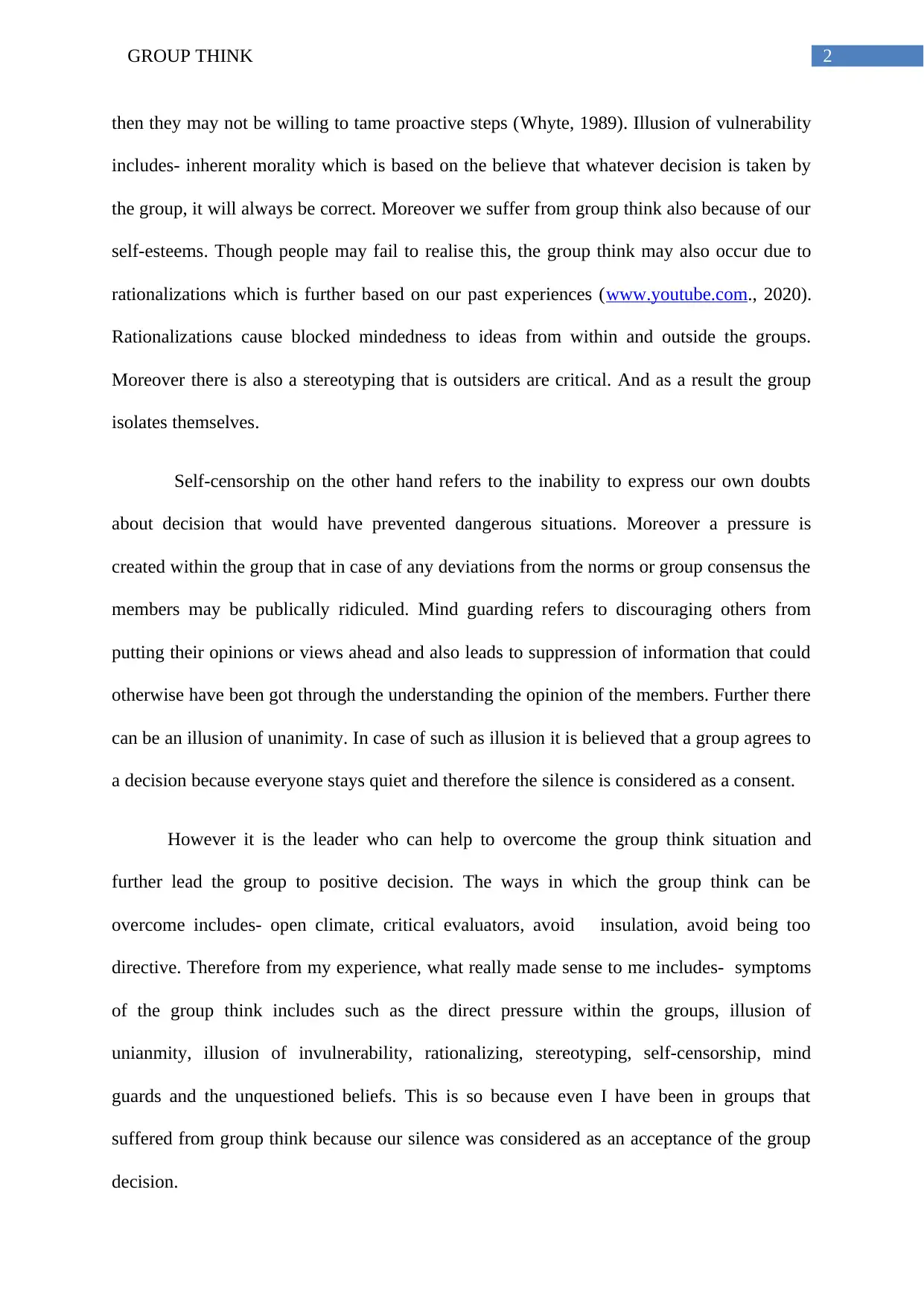
2GROUP THINK
then they may not be willing to tame proactive steps (Whyte, 1989). Illusion of vulnerability
includes- inherent morality which is based on the believe that whatever decision is taken by
the group, it will always be correct. Moreover we suffer from group think also because of our
self-esteems. Though people may fail to realise this, the group think may also occur due to
rationalizations which is further based on our past experiences (www.youtube.com., 2020).
Rationalizations cause blocked mindedness to ideas from within and outside the groups.
Moreover there is also a stereotyping that is outsiders are critical. And as a result the group
isolates themselves.
Self-censorship on the other hand refers to the inability to express our own doubts
about decision that would have prevented dangerous situations. Moreover a pressure is
created within the group that in case of any deviations from the norms or group consensus the
members may be publically ridiculed. Mind guarding refers to discouraging others from
putting their opinions or views ahead and also leads to suppression of information that could
otherwise have been got through the understanding the opinion of the members. Further there
can be an illusion of unanimity. In case of such as illusion it is believed that a group agrees to
a decision because everyone stays quiet and therefore the silence is considered as a consent.
However it is the leader who can help to overcome the group think situation and
further lead the group to positive decision. The ways in which the group think can be
overcome includes- open climate, critical evaluators, avoid insulation, avoid being too
directive. Therefore from my experience, what really made sense to me includes- symptoms
of the group think includes such as the direct pressure within the groups, illusion of
unianmity, illusion of invulnerability, rationalizing, stereotyping, self-censorship, mind
guards and the unquestioned beliefs. This is so because even I have been in groups that
suffered from group think because our silence was considered as an acceptance of the group
decision.
then they may not be willing to tame proactive steps (Whyte, 1989). Illusion of vulnerability
includes- inherent morality which is based on the believe that whatever decision is taken by
the group, it will always be correct. Moreover we suffer from group think also because of our
self-esteems. Though people may fail to realise this, the group think may also occur due to
rationalizations which is further based on our past experiences (www.youtube.com., 2020).
Rationalizations cause blocked mindedness to ideas from within and outside the groups.
Moreover there is also a stereotyping that is outsiders are critical. And as a result the group
isolates themselves.
Self-censorship on the other hand refers to the inability to express our own doubts
about decision that would have prevented dangerous situations. Moreover a pressure is
created within the group that in case of any deviations from the norms or group consensus the
members may be publically ridiculed. Mind guarding refers to discouraging others from
putting their opinions or views ahead and also leads to suppression of information that could
otherwise have been got through the understanding the opinion of the members. Further there
can be an illusion of unanimity. In case of such as illusion it is believed that a group agrees to
a decision because everyone stays quiet and therefore the silence is considered as a consent.
However it is the leader who can help to overcome the group think situation and
further lead the group to positive decision. The ways in which the group think can be
overcome includes- open climate, critical evaluators, avoid insulation, avoid being too
directive. Therefore from my experience, what really made sense to me includes- symptoms
of the group think includes such as the direct pressure within the groups, illusion of
unianmity, illusion of invulnerability, rationalizing, stereotyping, self-censorship, mind
guards and the unquestioned beliefs. This is so because even I have been in groups that
suffered from group think because our silence was considered as an acceptance of the group
decision.
⊘ This is a preview!⊘
Do you want full access?
Subscribe today to unlock all pages.

Trusted by 1+ million students worldwide
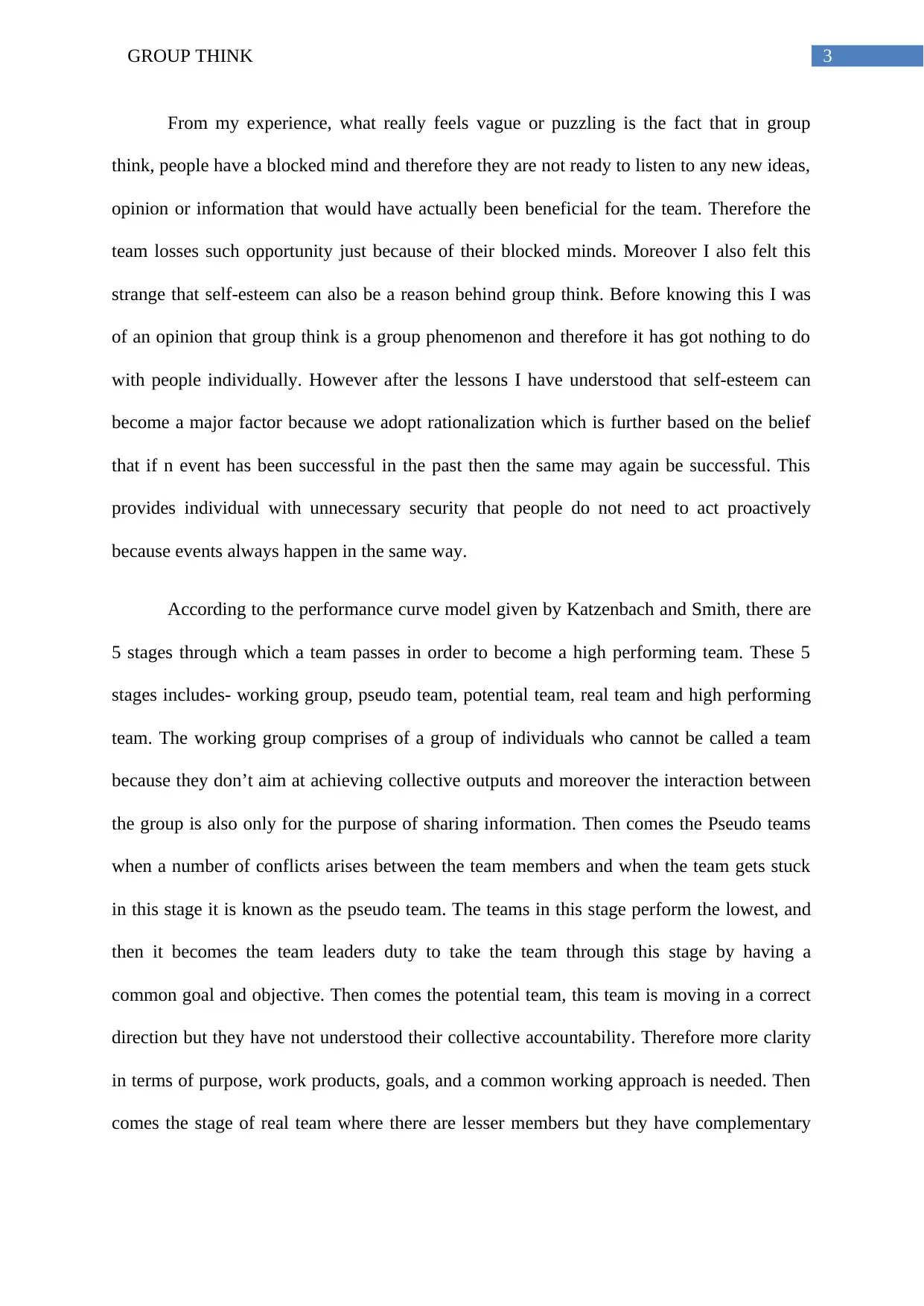
3GROUP THINK
From my experience, what really feels vague or puzzling is the fact that in group
think, people have a blocked mind and therefore they are not ready to listen to any new ideas,
opinion or information that would have actually been beneficial for the team. Therefore the
team losses such opportunity just because of their blocked minds. Moreover I also felt this
strange that self-esteem can also be a reason behind group think. Before knowing this I was
of an opinion that group think is a group phenomenon and therefore it has got nothing to do
with people individually. However after the lessons I have understood that self-esteem can
become a major factor because we adopt rationalization which is further based on the belief
that if n event has been successful in the past then the same may again be successful. This
provides individual with unnecessary security that people do not need to act proactively
because events always happen in the same way.
According to the performance curve model given by Katzenbach and Smith, there are
5 stages through which a team passes in order to become a high performing team. These 5
stages includes- working group, pseudo team, potential team, real team and high performing
team. The working group comprises of a group of individuals who cannot be called a team
because they don’t aim at achieving collective outputs and moreover the interaction between
the group is also only for the purpose of sharing information. Then comes the Pseudo teams
when a number of conflicts arises between the team members and when the team gets stuck
in this stage it is known as the pseudo team. The teams in this stage perform the lowest, and
then it becomes the team leaders duty to take the team through this stage by having a
common goal and objective. Then comes the potential team, this team is moving in a correct
direction but they have not understood their collective accountability. Therefore more clarity
in terms of purpose, work products, goals, and a common working approach is needed. Then
comes the stage of real team where there are lesser members but they have complementary
From my experience, what really feels vague or puzzling is the fact that in group
think, people have a blocked mind and therefore they are not ready to listen to any new ideas,
opinion or information that would have actually been beneficial for the team. Therefore the
team losses such opportunity just because of their blocked minds. Moreover I also felt this
strange that self-esteem can also be a reason behind group think. Before knowing this I was
of an opinion that group think is a group phenomenon and therefore it has got nothing to do
with people individually. However after the lessons I have understood that self-esteem can
become a major factor because we adopt rationalization which is further based on the belief
that if n event has been successful in the past then the same may again be successful. This
provides individual with unnecessary security that people do not need to act proactively
because events always happen in the same way.
According to the performance curve model given by Katzenbach and Smith, there are
5 stages through which a team passes in order to become a high performing team. These 5
stages includes- working group, pseudo team, potential team, real team and high performing
team. The working group comprises of a group of individuals who cannot be called a team
because they don’t aim at achieving collective outputs and moreover the interaction between
the group is also only for the purpose of sharing information. Then comes the Pseudo teams
when a number of conflicts arises between the team members and when the team gets stuck
in this stage it is known as the pseudo team. The teams in this stage perform the lowest, and
then it becomes the team leaders duty to take the team through this stage by having a
common goal and objective. Then comes the potential team, this team is moving in a correct
direction but they have not understood their collective accountability. Therefore more clarity
in terms of purpose, work products, goals, and a common working approach is needed. Then
comes the stage of real team where there are lesser members but they have complementary
Paraphrase This Document
Need a fresh take? Get an instant paraphrase of this document with our AI Paraphraser
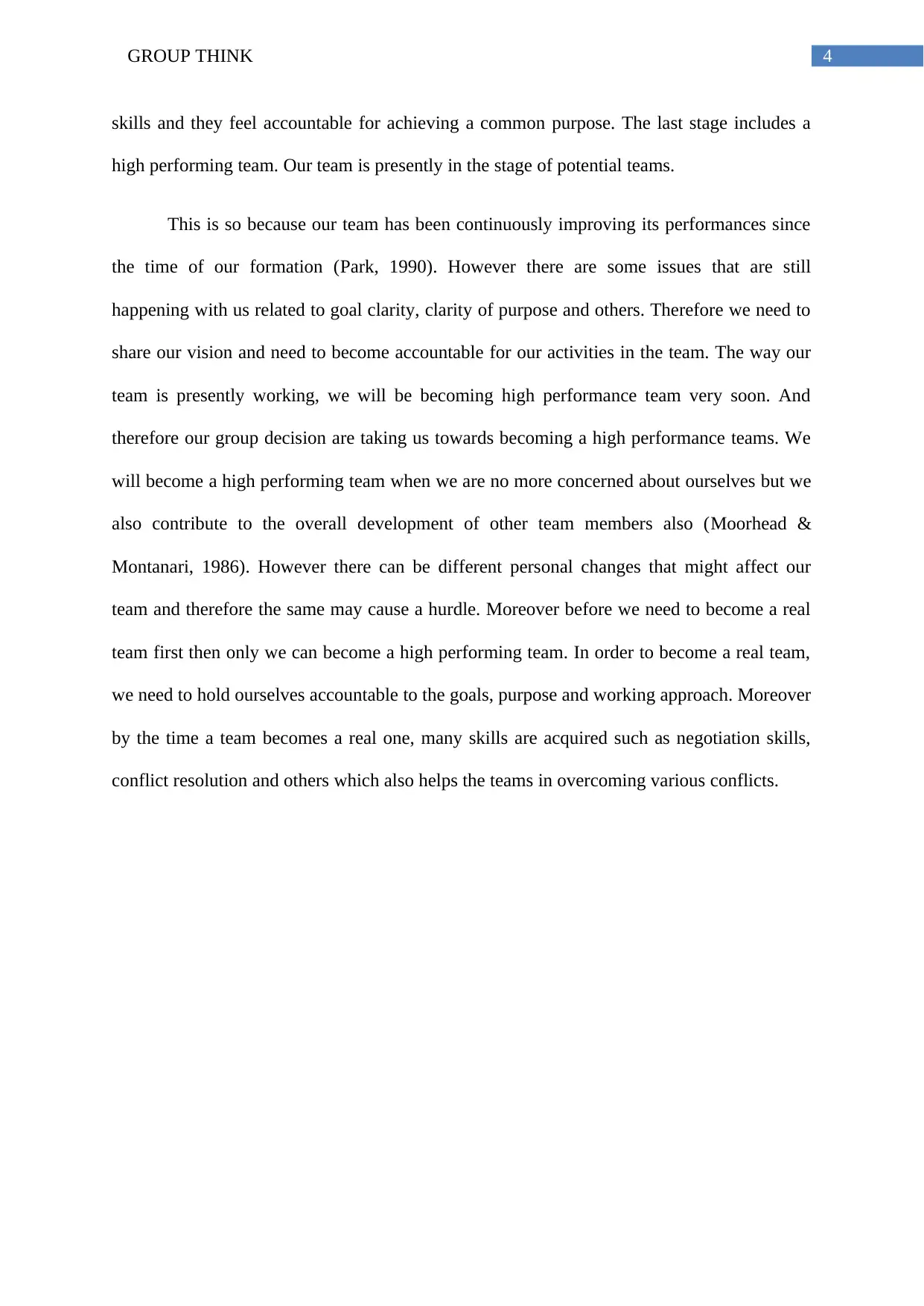
4GROUP THINK
skills and they feel accountable for achieving a common purpose. The last stage includes a
high performing team. Our team is presently in the stage of potential teams.
This is so because our team has been continuously improving its performances since
the time of our formation (Park, 1990). However there are some issues that are still
happening with us related to goal clarity, clarity of purpose and others. Therefore we need to
share our vision and need to become accountable for our activities in the team. The way our
team is presently working, we will be becoming high performance team very soon. And
therefore our group decision are taking us towards becoming a high performance teams. We
will become a high performing team when we are no more concerned about ourselves but we
also contribute to the overall development of other team members also (Moorhead &
Montanari, 1986). However there can be different personal changes that might affect our
team and therefore the same may cause a hurdle. Moreover before we need to become a real
team first then only we can become a high performing team. In order to become a real team,
we need to hold ourselves accountable to the goals, purpose and working approach. Moreover
by the time a team becomes a real one, many skills are acquired such as negotiation skills,
conflict resolution and others which also helps the teams in overcoming various conflicts.
skills and they feel accountable for achieving a common purpose. The last stage includes a
high performing team. Our team is presently in the stage of potential teams.
This is so because our team has been continuously improving its performances since
the time of our formation (Park, 1990). However there are some issues that are still
happening with us related to goal clarity, clarity of purpose and others. Therefore we need to
share our vision and need to become accountable for our activities in the team. The way our
team is presently working, we will be becoming high performance team very soon. And
therefore our group decision are taking us towards becoming a high performance teams. We
will become a high performing team when we are no more concerned about ourselves but we
also contribute to the overall development of other team members also (Moorhead &
Montanari, 1986). However there can be different personal changes that might affect our
team and therefore the same may cause a hurdle. Moreover before we need to become a real
team first then only we can become a high performing team. In order to become a real team,
we need to hold ourselves accountable to the goals, purpose and working approach. Moreover
by the time a team becomes a real one, many skills are acquired such as negotiation skills,
conflict resolution and others which also helps the teams in overcoming various conflicts.
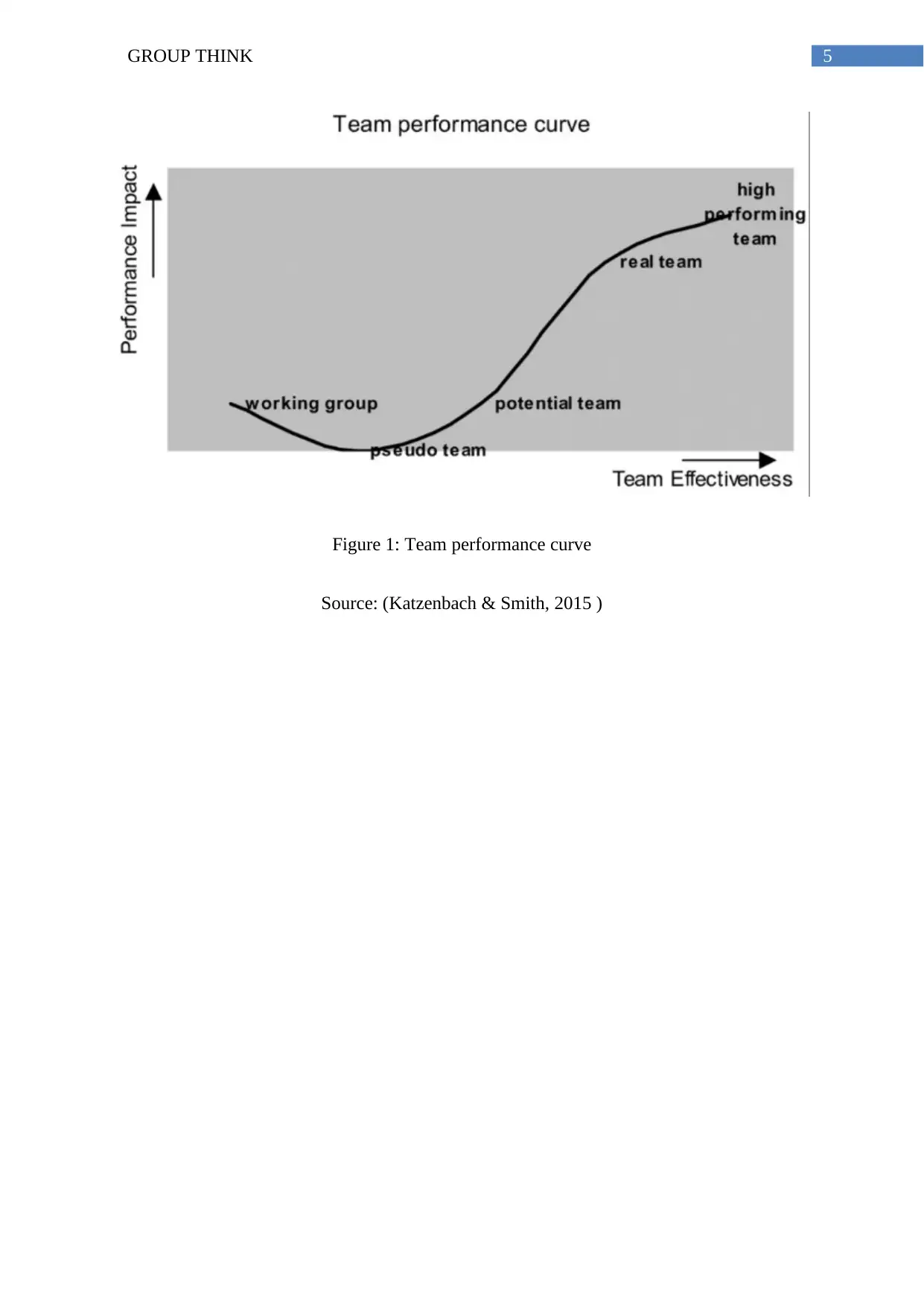
5GROUP THINK
Figure 1: Team performance curve
Source: (Katzenbach & Smith, 2015 )
Figure 1: Team performance curve
Source: (Katzenbach & Smith, 2015 )
⊘ This is a preview!⊘
Do you want full access?
Subscribe today to unlock all pages.

Trusted by 1+ million students worldwide
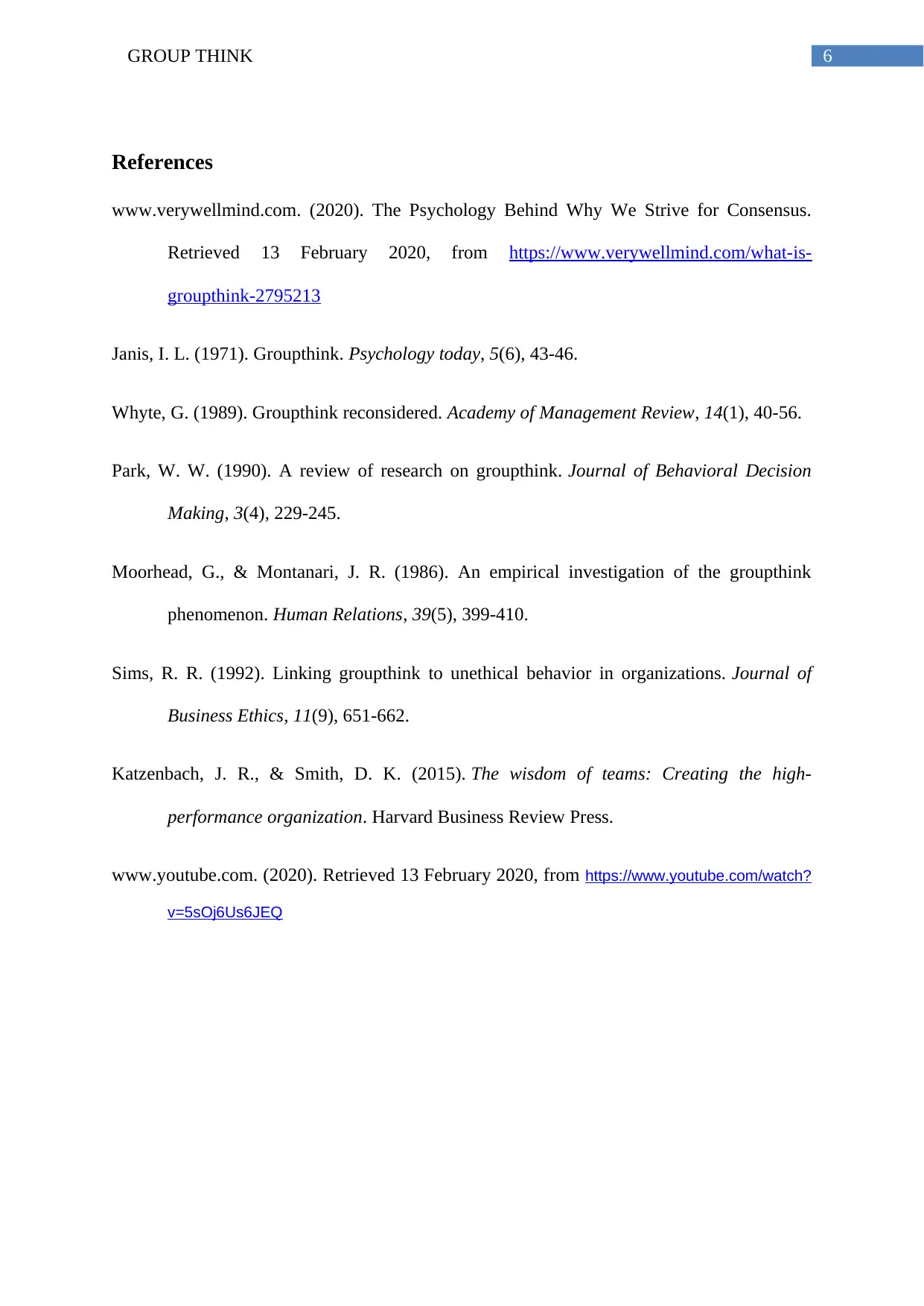
6GROUP THINK
References
www.verywellmind.com. (2020). The Psychology Behind Why We Strive for Consensus.
Retrieved 13 February 2020, from https://www.verywellmind.com/what-is-
groupthink-2795213
Janis, I. L. (1971). Groupthink. Psychology today, 5(6), 43-46.
Whyte, G. (1989). Groupthink reconsidered. Academy of Management Review, 14(1), 40-56.
Park, W. W. (1990). A review of research on groupthink. Journal of Behavioral Decision
Making, 3(4), 229-245.
Moorhead, G., & Montanari, J. R. (1986). An empirical investigation of the groupthink
phenomenon. Human Relations, 39(5), 399-410.
Sims, R. R. (1992). Linking groupthink to unethical behavior in organizations. Journal of
Business Ethics, 11(9), 651-662.
Katzenbach, J. R., & Smith, D. K. (2015). The wisdom of teams: Creating the high-
performance organization. Harvard Business Review Press.
www.youtube.com. (2020). Retrieved 13 February 2020, from https://www.youtube.com/watch?
v=5sOj6Us6JEQ
References
www.verywellmind.com. (2020). The Psychology Behind Why We Strive for Consensus.
Retrieved 13 February 2020, from https://www.verywellmind.com/what-is-
groupthink-2795213
Janis, I. L. (1971). Groupthink. Psychology today, 5(6), 43-46.
Whyte, G. (1989). Groupthink reconsidered. Academy of Management Review, 14(1), 40-56.
Park, W. W. (1990). A review of research on groupthink. Journal of Behavioral Decision
Making, 3(4), 229-245.
Moorhead, G., & Montanari, J. R. (1986). An empirical investigation of the groupthink
phenomenon. Human Relations, 39(5), 399-410.
Sims, R. R. (1992). Linking groupthink to unethical behavior in organizations. Journal of
Business Ethics, 11(9), 651-662.
Katzenbach, J. R., & Smith, D. K. (2015). The wisdom of teams: Creating the high-
performance organization. Harvard Business Review Press.
www.youtube.com. (2020). Retrieved 13 February 2020, from https://www.youtube.com/watch?
v=5sOj6Us6JEQ
1 out of 7